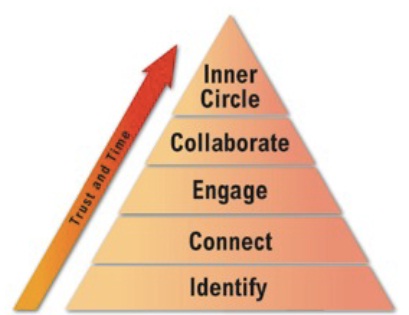In the 5th part of this six-article series on how to build your own networking strategy, Heather Townsend looks in depth at the fourth stage in building your own networking strategy; building relationships to add into your network.
Sadly, many trainers' viewpoint of networking is it is all about the process of 'finding' contacts. I am reminded of the great quote by a good friend of mine, Rob Brown:
"stop counting contacts, start counting conversations"
If you pulled open your desk drawer, how many business cards would prompt a thought, similar to, 'I was meant to get back to them…'?
That's probably the biggest mistake trainers make with their networking activities. They focus too much on finding contacts rather than deepening and maintaining the relationships which will help them achieve their networking goals. It’s all too easy to forget about following up on a conversation – particularly when you have met 15 people that evening and have a workshop to deliver the next day.
In the last stage of the process Juliet identified who she needed to meet to generate three days of associate work a month. She then used a simple system to categorise the people she wanted to meet.
A-lister: Someone who is likely to help me generate three days of associate work a month OR one day of directly sourced work, in the short and medium term
B-lister: Someone who may be able to help me generate three days of associate work a month OR one day of directly sourced work in the medium and long term
C-lister: Someone who is unlikely to help me generate three days of associate work a month OR one day of directly sourced work in the long term
Just like Juliet, in your networking strategy you need to decide on what you will do as a result of meeting an A, B or C lister. This is what Juliet choose to do:
- She asked to connect with everyone on LinkedIn and Twitter (after all, circumstances can always change), and if they were a trainer or a retail specialist added them to her trainers to stay close to, and retail professionals lists on Twitter
- For all A-listers, Juliet asked for a follow up conversations and put in place a rolling three-month relationship plan. She diarised next steps for each of these relationship plans
- She arranged to have a phone call with her B-listers to help her prioritise and decide on the level of contact needed with this relationship
Your aim with your relationship plan is to deepen the relationships which matter to you. The best networked trainers are not those that are always out there working the room, or having coffees; it is the trainers who are very picky with who they choose to spend time with.
The state of your relationship can be defined as one of five levels, as per my five-level relationship level model: Here is my five level system, which allows you to categorise the state of your relationship:

Level 1: Identify
At this level, you have just become aware of this contact. Maybe, someone has mentioned them in conversation, perhaps you have seen one of their tweets. Or perhaps they are on an attendance list of an event you are attending.
Level 2: Connect
At this point you have physically or virtually met a contact, and started a one- or two-way conversation, i.e. you have connected. For example, you may have talked to them at a face-to-face networking event, or exchanged some tweets or posts within an online forum.
Level 3: Engage
At this point, you have taken a conscious decision to strengthen the relationship, and move beyond small talk. This means that you have taken the time to have a one-to-one meeting with them, whether in person, or by phone.
Level 4: Collaborate
The trust has built within the relationship to the point where you have agreed to help each other, pass referrals, and potentially actively looking for ways to work together.
Level 5: Inner circle
The relationship is now such that you have worked together, and regularly recommend each other's services. There is a strong possibility that your relationship has moved from a purely professional relationship into a personal friendship.
Juliet went back to her network map again, and categorised the relationship level for all of her A & B listers. If the relationship level with these people was not at least a level 3, Juliet added next steps to her networking action plan to meet with these people.
It’s all very well having relationship plans for the folks who matter to you. However, like Juliet, you need to actively implement these plans. My recommendation is that every month you sit down with all your relationship plans. As you go through each relationship plan, check you have three months of the right level of contact planned and in your diary. Then, extend your relationship plans by another month.
If you have admin assistance available to you, use them to book in your planned meetings and events you will attend.
In the next and final article in the series, we will focus on what networking activities you need to do to ‘maintain’ the relationships with the right people to in your network.
Heather Townsend helps professionals become the ‘Go To Expert’. She is the author of the award-winning and best-selling book on networking, ‘The FT Guide to Business Networking’, and the co-author of ‘How to make partner and still have a life’. Heather regularly blogs at ‘Joined Up Networking’ and ‘How to make partner’
In the 5th part of this six-article series on how to build your own networking strategy, Heather Townsend looks in depth at the fourth stage in building your own networking strategy; building relationships to add into your network.
Sadly, many trainers' viewpoint of networking is it is all about the process of 'finding' contacts. I am reminded of the great quote by a good friend of mine, Rob Brown:
"stop counting contacts, start counting conversations"
If you pulled open your desk drawer, how many business cards would prompt a thought, similar to, 'I was meant to get back to them...'?
That's probably the biggest mistake trainers make with their networking activities. They focus too much on finding contacts rather than deepening and maintaining the relationships which will help them achieve their networking goals. It’s all too easy to forget about following up on a conversation - particularly when you have met 15 people that evening and have a workshop to deliver the next day.
In the last stage of the process Juliet identified who she needed to meet to generate three days of associate work a month. She then used a simple system to categorise the people she wanted to meet.
A-lister: Someone who is likely to help me generate three days of associate work a month OR one day of directly sourced work, in the short and medium term
B-lister: Someone who may be able to help me generate three days of associate work a month OR one day of directly sourced work in the medium and long term
C-lister: Someone who is unlikely to help me generate three days of associate work a month OR one day of directly sourced work in the long term
Just like Juliet, in your networking strategy you need to decide on what you will do as a result of meeting an A, B or C lister. This is what Juliet choose to do:
- She asked to connect with everyone on LinkedIn and Twitter (after all, circumstances can always change), and if they were a trainer or a retail specialist added them to her trainers to stay close to, and retail professionals lists on Twitter
- For all A-listers, Juliet asked for a follow up conversations and put in place a rolling three-month relationship plan. She diarised next steps for each of these relationship plans
- She arranged to have a phone call with her B-listers to help her prioritise and decide on the level of contact needed with this relationship
Your aim with your relationship plan is to deepen the relationships which matter to you. The best networked trainers are not those that are always out there working the room, or having coffees; it is the trainers who are very picky with who they choose to spend time with.
The state of your relationship can be defined as one of five levels, as per my five-level relationship level model: Here is my five level system, which allows you to categorise the state of your relationship:

Level 1: Identify
At this level, you have just become aware of this contact. Maybe, someone has mentioned them in conversation, perhaps you have seen one of their tweets. Or perhaps they are on an attendance list of an event you are attending.
Level 2: Connect
At this point you have physically or virtually met a contact, and started a one- or two-way conversation, i.e. you have connected. For example, you may have talked to them at a face-to-face networking event, or exchanged some tweets or posts within an online forum.
Level 3: Engage
At this point, you have taken a conscious decision to strengthen the relationship, and move beyond small talk. This means that you have taken the time to have a one-to-one meeting with them, whether in person, or by phone.
Level 4: Collaborate
The trust has built within the relationship to the point where you have agreed to help each other, pass referrals, and potentially actively looking for ways to work together.
Level 5: Inner circle
The relationship is now such that you have worked together, and regularly recommend each other's services. There is a strong possibility that your relationship has moved from a purely professional relationship into a personal friendship.
Juliet went back to her network map again, and categorised the relationship level for all of her A & B listers. If the relationship level with these people was not at least a level 3, Juliet added next steps to her networking action plan to meet with these people.
It’s all very well having relationship plans for the folks who matter to you. However, like Juliet, you need to actively implement these plans. My recommendation is that every month you sit down with all your relationship plans. As you go through each relationship plan, check you have three months of the right level of contact planned and in your diary. Then, extend your relationship plans by another month.
If you have admin assistance available to you, use them to book in your planned meetings and events you will attend.
In the next and final article in the series, we will focus on what networking activities you need to do to ‘maintain’ the relationships with the right people to in your network.
Heather Townsend helps professionals become the ‘Go To Expert’. She is the author of the award-winning and best-selling book on networking, ‘The FT Guide to Business Networking’, and the co-author of ‘How to make partner and still have a life’. Heather regularly blogs at ‘Joined Up Networking’ and ‘How to make partner’




